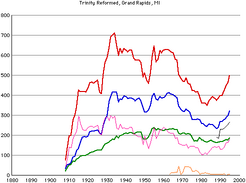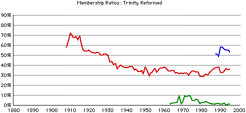History[]
Trinity Reformed was organized on the West Side in 1908 as an English-language daughter church of Seventh Reformed.
Visit the Trinity Reformed website.
Historical Details[]
Locations[]
- Laroy Wagon Works, NE corner of Alpine Ave. and Myrtle St. NW, 1908-16
- 1224 Davis Ave. NW, built 1913-16
Pastors[]
- Teunis W. Muilenburg, 1908-11
- Rense H. Joldersma, 1912-13
- John G. Van Zomeren, 1914-26
- Edward J. Masselink, 1927-29
- Raymond B. Drukker, 1930-35
- Standley D. Schipper, 1936-49
- Bet E. Van Soest, 1951-56
- John R. Staat, 1957-59
- John J. Arnold, 1960-68
- Richard Bates, 1969-76
- Craig A. Wagner, "mparl", 1975-78 - what is mparl?
- James W. Baar, assistant, 1976-79
- Robert A. Wierenga, 1978-88
- Victoria M. Menning, 1989-
- Bruce A. Menning, copastor, 1989-
Membership Overview[]

Membership data, Trinity Reformed, Grand Rapids, MI
Membership Data[]
Heavy lines: green (lower) shows membership in families; blue (middle), professing members; red (top), total members. Thin lines: magenta (middle), non-professing members; orange (lower), inactive members; black (top), average worship attendance.

Membership ratios, Trinity Reformed, Grand Rapids, MI
Membership Ratios[]
Red line (middle) shows nonprofessing members as a percentage of total membership (inactive members exluded); green (lower), inactive members as percentage of total membership; and blue (higher) average worship attendance of total membership.

Five year growth rate, Trinity Reformed, Grand Rapids, MI
Five Year Growth Rate[]
Red line shows five year growth rate. A five year growth rate between 10% and -10% is considered stable; greater than 10% indicates a growing congregation; one below -10% indicates a church in decline. This makes no allowance for daughter churches.
Data source: Acts of Synod of the Reformed Church in America. Dates are year prior to publication date since data is gathered at the end of one year and published in the next.